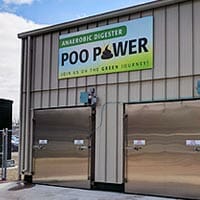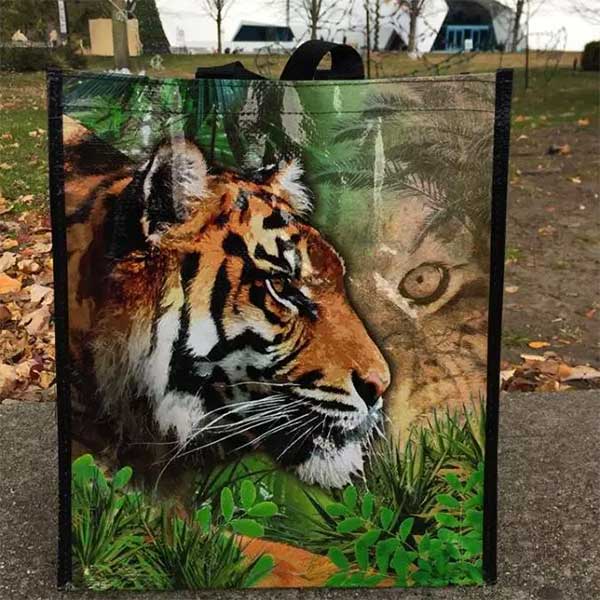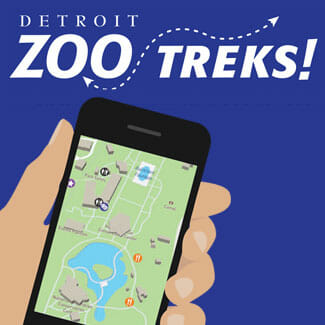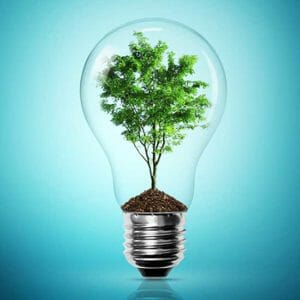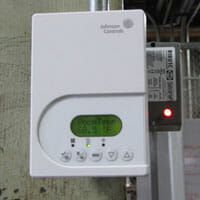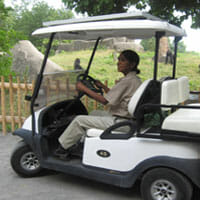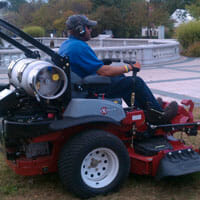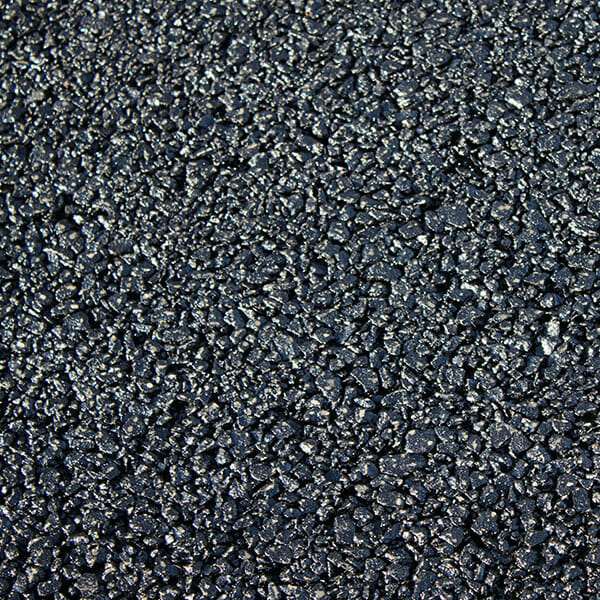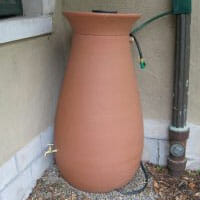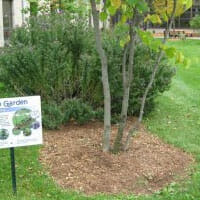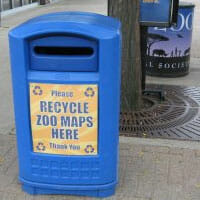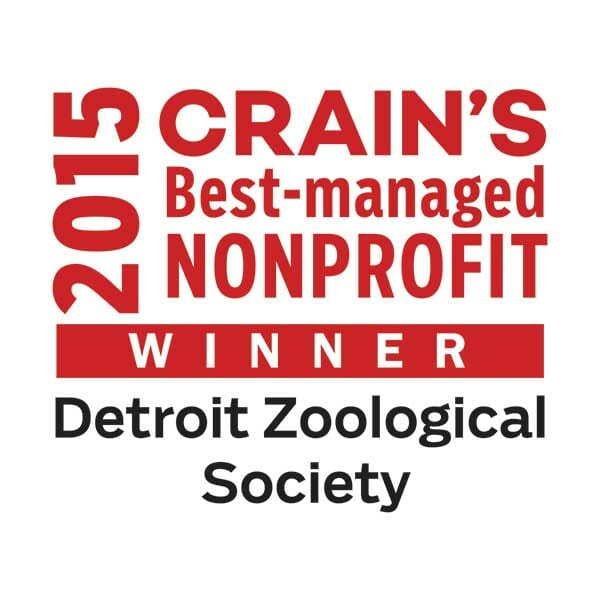Join the Detroit Zoological Society on our Green Journey as we work to reduce our environmental impact and create a better future for wildlife and wild places.
Everything we do is guided by our Greenprint initiative, a sustainable roadmap we developed to continuously refine and improve our facilities and daily practices, develop new policies and programs and improve green literacy and action in our community. It is the lens through which we make innovative strategic plans for the Detroit Zoo, the Belle Isle Nature Center, the future Great Lakes Center for Nature and the world around us as we create a healthier environment for animals, people and the planet.
What We’re Doing
Anaerobic Digester
Get a whiff of this! The anaerobic digester at the Detroit Zoo is the first in Michigan and the first zoo-based system of its kind in the country. The digester annually converts 500 tons of animal manure and other organic waste into a methane-rich gas that helps power the Ruth Roby Glancy Animal Health Complex, leaving a nutrient-rich fertilizer as a byproduct. This compost, called Detroit Zoo Poo, is available for purchase at Zoo concessions for guests to use in their gardens at home.
Get a whiff of this! The anaerobic digester at the Detroit Zoo is the first in Michigan and the first zoo-based system of its kind in the country. The digester annually converts 500 tons of animal manure and other organic waste into a methane-rich gas that helps power the Ruth Roby Glancy Animal Health Complex, leaving a nutrient-rich fertilizer as a byproduct. This compost, called Detroit Zoo Poo, is available for purchase at Zoo concessions for guests to use in their gardens at home.
Plastic Reduction
The DZS is keeping 60,000 plastic bottles out of the waste stream annually by no longer selling bottled water at the Detroit Zoo. Previously the No. 1 seller at Zoo concessions, which generated nearly a quarter of a million dollars in annual sales, bottled water is the single-largest contributor to plastic waste in the U.S. Visitors may bring their own water bottles or purchase inexpensive reusable bottles at Zoo concessions, which can be refilled for free at one of 21 filtered-water stations throughout the grounds. Additionally, the DZS no longer provides plastic bags for gift shop purchases; visitors are encouraged to bring their own bags or purchase wildlife-themed reusable bags at Zoofari Market, Arctic Outpost, Drake Passage Gifts or any of the souvenir stands. Straws are also not provided with beverages at Zoo concessions.
The DZS is keeping 60,000 plastic bottles out of the waste stream annually by no longer selling bottled water at the Detroit Zoo. Previously the No. 1 seller at Zoo concessions, which generated nearly a quarter of a million dollars in annual sales, bottled water is the single-largest contributor to plastic waste in the U.S. Visitors may bring their own water bottles or purchase inexpensive reusable bottles at Zoo concessions, which can be refilled for free at one of 21 filtered-water stations throughout the grounds. Additionally, the DZS no longer provides plastic bags for gift shop purchases; visitors are encouraged to bring their own bags or purchase wildlife-themed reusable bags at Zoofari Market, Arctic Outpost, Drake Passage Gifts or any of the souvenir stands. Straws are also not provided with beverages at Zoo concessions.
-
Energy
Solar Engery
The smartflower, an all-in-one ground-mounted solar-panel system, is blooming in the garden just east of the wildlife Carousel at the Detroit Zoo and is estimated to generate more than 4,000 kilowatts of electricity annually. Based on the concept of how a sunflower follows the sun, the 16-by-16-foot system features 12 solar “petals” that trail the sun across the sky throughout the day via a GPS-based dual-axis tracker.
The smartflower, an all-in-one ground-mounted solar-panel system, is blooming in the garden just east of the wildlife Carousel at the Detroit Zoo and is estimated to generate more than 4,000 kilowatts of electricity annually. Based on the concept of how a sunflower follows the sun, the 16-by-16-foot system features 12 solar “petals” that trail the sun across the sky throughout the day via a GPS-based dual-axis tracker.
Renewable Electricity
The Detroit Zoo’s electricity usage is 100% offset by donated Renewable Energy Credits (RECs). This is another major step on our Green Journey that has distinguished us as the greenest zoo in America. Electricity generated from renewable sources results in less environmental waste and pollution and displaces other non-renewable sources from the electric grid. It also serves to build the market for renewable energy, which currently accounts for less than 10 percent of total electricity generated nationwide.
The Detroit Zoo’s electricity usage is 100% offset by donated Renewable Energy Credits (RECs). This is another major step on our Green Journey that has distinguished us as the greenest zoo in America. Electricity generated from renewable sources results in less environmental waste and pollution and displaces other non-renewable sources from the electric grid. It also serves to build the market for renewable energy, which currently accounts for less than 10 percent of total electricity generated nationwide.
Energy Efficiency Upgrades
In 2012, we completed a $2 million energy efficiency project for upgrades including lighting, mechanical, controls and water conservation. This project promises to save the Zoo nearly $275,000 in annual utility costs with a payback of 6.5 years and a savings of more than 1,500 tons of carbon dioxide. The energy efficiency upgrades span more than 50 Detroit Zoo buildings and include installation of additional utility meters and low-flow toilets as well as rooftop unit upgrades and boiler control upgrades. We continue to find ways to make our operations more efficient and lessen our use of fossil fuels.
In 2012, we completed a $2 million energy efficiency project for upgrades including lighting, mechanical, controls and water conservation. This project promises to save the Zoo nearly $275,000 in annual utility costs with a payback of 6.5 years and a savings of more than 1,500 tons of carbon dioxide. The energy efficiency upgrades span more than 50 Detroit Zoo buildings and include installation of additional utility meters and low-flow toilets as well as rooftop unit upgrades and boiler control upgrades. We continue to find ways to make our operations more efficient and lessen our use of fossil fuels.
Lighting Upgrades
As part of our energy efficiency improvement project, the Zoo continues to install lighting upgrades throughout our grounds. LED lights in the Great Apes of Harambee indoor habitat simulate sunrise and sunset to improve animal comfort, and LED lights are also used at the parking structure, Picnic Grove Restrooms and Events Pavilion. In addition, more than five million LED lights illuminate the Zoo for our Wild Lights event.
As part of our energy efficiency improvement project, the Zoo continues to install lighting upgrades throughout our grounds. LED lights in the Great Apes of Harambee indoor habitat simulate sunrise and sunset to improve animal comfort, and LED lights are also used at the parking structure, Picnic Grove Restrooms and Events Pavilion. In addition, more than five million LED lights illuminate the Zoo for our Wild Lights event.
Solar Powered Carts
During our peak season, 38 solar/electric vehicles are used by staff to carry equipment, tools and the occasional guest throughout the Zoo. The panels on top of these vehicles collect solar energy and provide supplemental power. However, we have reduced golf cart usage by 25% using bicycles and walking; more than 60 bicycles are in use by our staff.
During our peak season, 38 solar/electric vehicles are used by staff to carry equipment, tools and the occasional guest throughout the Zoo. The panels on top of these vehicles collect solar energy and provide supplemental power. However, we have reduced golf cart usage by 25% using bicycles and walking; more than 60 bicycles are in use by our staff.
Combustion Engine Fuels
The two propane mowers used on Zoo grounds are more efficient than traditional gas-powered mowers. By 2013, all 11 diesel vehicles and two diesel generators had been switched to B5 biodiesel. Two hybrid vehicles are also used on and off-site the Zoo. Using alternative fuels, hybrid technology and fewer gas-powered vehicles in the Zoo continues to increase our fuel economy.
The two propane mowers used on Zoo grounds are more efficient than traditional gas-powered mowers. By 2013, all 11 diesel vehicles and two diesel generators had been switched to B5 biodiesel. Two hybrid vehicles are also used on and off-site the Zoo. Using alternative fuels, hybrid technology and fewer gas-powered vehicles in the Zoo continues to increase our fuel economy.
Holiday Light Recycling
The Detroit Zoological Society (DZS) offers free holiday light recycling during Wild Lights. Guests are encouraged to bring in broken holiday lights and the DZS will properly recycle them.
The Detroit Zoological Society (DZS) offers free holiday light recycling during Wild Lights. Guests are encouraged to bring in broken holiday lights and the DZS will properly recycle them.
-
Water Management
Permeable Pavement
The DZS has incorporated permeable pavement in a parking lot and visitor pathways at the Detroit Zoo, which reduces storm water runoff and improves water quality by filtering pollutants.
The DZS has incorporated permeable pavement in a parking lot and visitor pathways at the Detroit Zoo, which reduces storm water runoff and improves water quality by filtering pollutants.
Rain Barrels
Rain barrels are installed at the Picnic Grove Restrooms, Park Safety office and the greenhouses at the Administration Complex. Water that is collected from these containers is used on surrounding landscape by our staff and volunteer gardeners. Keeping rain water out of our sewage system and in our watershed is an environmental benefit and a cost savings.
Rain barrels are installed at the Picnic Grove Restrooms, Park Safety office and the greenhouses at the Administration Complex. Water that is collected from these containers is used on surrounding landscape by our staff and volunteer gardeners. Keeping rain water out of our sewage system and in our watershed is an environmental benefit and a cost savings.
Rain Garden
This rain garden is located at the Ford Education Center. The vegetation absorbs the rainwater from an underground pipe that transports the water to these plants. A rain garden helps keep clean, fresh rainwater out of the sewer system and reduces pollution.
This rain garden is located at the Ford Education Center. The vegetation absorbs the rainwater from an underground pipe that transports the water to these plants. A rain garden helps keep clean, fresh rainwater out of the sewer system and reduces pollution.
-
Waste Management
Trash and Recycling Containers
We have acquired and placed more than 140 recycling and trash containers throughout the Zoo. The circular openings on the recycling container allow for better sorting of recyclable materials. Waste and recycling containers are also paired, so that guests will always have the option to recycle, rather than put their items in a landfill.
We have acquired and placed more than 140 recycling and trash containers throughout the Zoo. The circular openings on the recycling container allow for better sorting of recyclable materials. Waste and recycling containers are also paired, so that guests will always have the option to recycle, rather than put their items in a landfill.
Boardwalk Recycled Materials
The boardwalk at the Cotton Family Wetlands is constructed with a material made of 50% plastic bags, 45% recycled hardwood and 5% polymers. Products like these keep materials out of landfills and turn them into a valuable building material.
The boardwalk at the Cotton Family Wetlands is constructed with a material made of 50% plastic bags, 45% recycled hardwood and 5% polymers. Products like these keep materials out of landfills and turn them into a valuable building material.
Electronic Waste Recycling
We continue annual electronic waste collection events. The inaugural event in 2011 diverted more than 103,000 pounds of computers, monitors, printers, televisions and miscellaneous electronics from the landfill.
We continue annual electronic waste collection events. The inaugural event in 2011 diverted more than 103,000 pounds of computers, monitors, printers, televisions and miscellaneous electronics from the landfill.
Zoo Map Recycling
This container is located at the exit of the Zoo so that guest may recycle their maps. The maps are refolded by volunteers and reused whenever possible. If they cannot be reused, they are recycled with the rest of our paper products.
This container is located at the exit of the Zoo so that guest may recycle their maps. The maps are refolded by volunteers and reused whenever possible. If they cannot be reused, they are recycled with the rest of our paper products.
-
Awards
Keep Michigan Beautiful Award
The DZS received the 2017 Keep Michigan Beautiful Award in recognition of our ongoing efforts in environmental sustainability by Keep Michigan Beautiful, Inc.
Best and Brightest Sustainable Companies
The DZS was named one of Michigan’s and the nation’s 2016 Best and Brightest Sustainable Companies by the National Association for Business Resources.
Best and Brightest Sustainable Companies
In recognition of our environmental leadership, the DZS was named the 2015 Best-Managed Nonprofit by Crain’s Detroit Business, winning the publication’s top honor for exceptional mission-driven management practices.
In recognition of our environmental leadership, the DZS was named the 2015 Best-Managed Nonprofit by Crain’s Detroit Business, winning the publication’s top honor for exceptional mission-driven management practices.
Green Award
The DZS was honored with the 2015 Green Award by the Association of Zoos & Aquariums, designating the Detroit Zoo as the greenest zoo in America.
The DZS was honored with the 2015 Green Award by the Association of Zoos & Aquariums, designating the Detroit Zoo as the greenest zoo in America.
-
Events
The DZS highlights our sustainability initiatives while hosting an electronics recycling event at the Detroit Zoo. More than 4,500 pounds of electronics were dropped off at the Zoo by guests, staff and volunteers during our inaugural event in 2018, reducing the amount of e-waste that ends up in landfills.
What Can You Do?
Consider a reusable bottle to help decrease unnecessary plastic pollution.
- One million sea birds and 100,000 marine mammals are killed every year from plastic in our oceans.
- U.S. consumers go through 1,500 bottles of water every second, of which only 300 will get recycled.
- 25% oil plus three full bottles of water go into producing 1 plastic bottle.
Consider lowering the temperature in your home.
- Lowering your thermostat by just 1 degree saves $44-73 a year on your power bill– 41% of your energy usage goes to heat your home.
Plant a tree.
- A single tree can absorb 10 pounds of air pollutants a year and produce nearly 260 pounds of oxygen – enough to support two people.
Consider carpooling.
- Driving an average of 1,000 miles a month produces about 120 tons of carbon dioxide a year.
Check air pressure regularly.
- If all the cars on U.S. roads had properly inflated tires, it would save nearly 2 billion gallons of gasoline a year.
Activate sleep mode on your computer when not in use.
- Activating sleep mode on your computer can prevent roughly 300 pounds of carbon dioxide emissions a year.
Compost your food scraps and help to reduce greenhouse gas.
- Each year, 21.5 million tons of food waste is being sent to landfills instead of being composted, creating more greenhouse gas emissions than two million cars on the road.
Recycle your used electronics (e-waste) responsibly to keep toxic chemicals out of landfills and potentially out of groundwater.
- More than 85% of all e-waste goes unrecycled, while 3 million tons enter the waste stream.
Consider a reusable coffee mug.
- A single polystyrene (Styrofoam) cup contains one billion molecules of CFCs – that’s 1,000,000,000,000,000,000.
Download our shades of Green Guide.
Shades of Green (PDF)
DZS Blog
Discover green tips on the Detroit Zoological Society blog.
DZS Blog
Discover green tips on the Detroit Zoological Society blog.
DZS Blog
Zoo Treks
Follow our sustainability Trek on your next visit to the Detroit Zoo.
Zoo Treks
Follow our sustainability Trek on your next visit to the Detroit Zoo.
Zoo Treks
